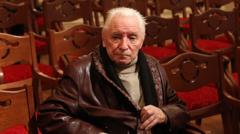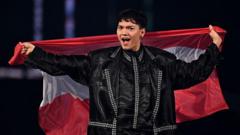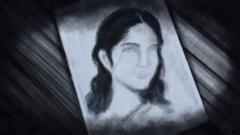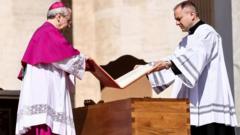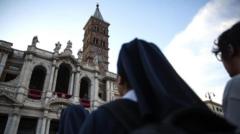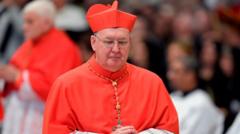**The theyyam ritual in Kerala is a potent blend of spirituality and performance art, revealing deep cultural beliefs and community connections.**
**Divine Transformations: Unveiling the Artistry of Theyyam in Kerala**
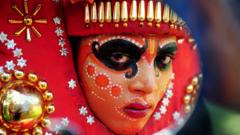
**Divine Transformations: Unveiling the Artistry of Theyyam in Kerala**
**Explore the rich tapestry of the theyyam ritual, where performers embody deities through artful tradition in India.**
In the lush landscapes of Kerala, India, the ancient theyyam ritual captivates audiences with its vibrant displays of artistry, devotion, and cultural heritage. Spanning nearly three centuries, this folktale performance draws from tribal traditions that predate Hinduism, intertwining with elements of Hindu mythology. Annually, approximately a thousand theyyam performances take place across temples and family estates, where predominantly male performers from marginalized castes transform into divine embodiments through elaborate costumes and intensive dance.
They say the spirit of the gods comes alive during the electrifying theyyam seasons that stretch from November to April, inviting thousands of spectators. Infused with dramatic storytelling, these performances feature thrilling feats like fire-walking and chanting, reflecting an intersection of ritual theatre and community devotion. Notably, historian KK Gopalakrishnan has traced his family's enduring legacy of hosting theyyam in a new book, “Theyyam: An Insider's Vision.” He emphasizes how this art form evolved, including new contributions from Muslim performers, showcasing the tradition's deep roots in tribal practices.
Gopalakrishnan's ancestral home in Kasaragod becomes the hub for these performances, which honor a range of themes—from ancestral veneration to worship of ecological spirits. Rituals frequently commence in sacred forests, believed to be the realm of the deities. The responsibilities in these rituals are typically managed by the senior-most male member of the Nambiar community, while women maintain the familial and ceremonial traditions, signifying their vital role in sustaining these customs.
Occupying the central role in such performances are the dedicated artists, who, through ornate costumes and paint, morph into deities. Their physical endurance is tested as they traverse flames, embodying the power and spirituality of the divine. Their dramatic expressions, intense dances, and the usage of fire convey deeper meanings—representing the cleansing force of the divine and delivering powerful symbolism of protection against malevolent forces.
Rituals are enriched by elaborate visual elements; distinct facial paint designs and vibrant colors tailored to each deity illustrate the rich cultural tapestry of the theyyam tradition. Some performers may opt for masks instead of makeup, yet all celebrate the animistic roots of the rituals, highlighting humanity's connection to nature.
As the performances unfold, moments of spiritual release emerge when devotees approach the performers, seeking blessings and solace. Each interaction deepens the ties between the performers, the divine, and the audience, drawing all involved into a sacred space where devotion intermingles with cultural practice, illustrating the profound significance of theyyam in the artistic and spiritual landscape of Kerala.
They say the spirit of the gods comes alive during the electrifying theyyam seasons that stretch from November to April, inviting thousands of spectators. Infused with dramatic storytelling, these performances feature thrilling feats like fire-walking and chanting, reflecting an intersection of ritual theatre and community devotion. Notably, historian KK Gopalakrishnan has traced his family's enduring legacy of hosting theyyam in a new book, “Theyyam: An Insider's Vision.” He emphasizes how this art form evolved, including new contributions from Muslim performers, showcasing the tradition's deep roots in tribal practices.
Gopalakrishnan's ancestral home in Kasaragod becomes the hub for these performances, which honor a range of themes—from ancestral veneration to worship of ecological spirits. Rituals frequently commence in sacred forests, believed to be the realm of the deities. The responsibilities in these rituals are typically managed by the senior-most male member of the Nambiar community, while women maintain the familial and ceremonial traditions, signifying their vital role in sustaining these customs.
Occupying the central role in such performances are the dedicated artists, who, through ornate costumes and paint, morph into deities. Their physical endurance is tested as they traverse flames, embodying the power and spirituality of the divine. Their dramatic expressions, intense dances, and the usage of fire convey deeper meanings—representing the cleansing force of the divine and delivering powerful symbolism of protection against malevolent forces.
Rituals are enriched by elaborate visual elements; distinct facial paint designs and vibrant colors tailored to each deity illustrate the rich cultural tapestry of the theyyam tradition. Some performers may opt for masks instead of makeup, yet all celebrate the animistic roots of the rituals, highlighting humanity's connection to nature.
As the performances unfold, moments of spiritual release emerge when devotees approach the performers, seeking blessings and solace. Each interaction deepens the ties between the performers, the divine, and the audience, drawing all involved into a sacred space where devotion intermingles with cultural practice, illustrating the profound significance of theyyam in the artistic and spiritual landscape of Kerala.






